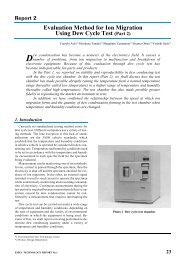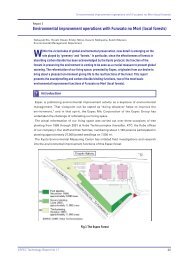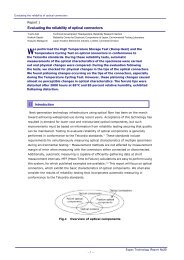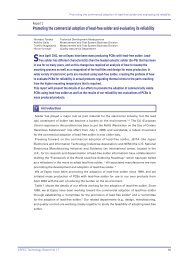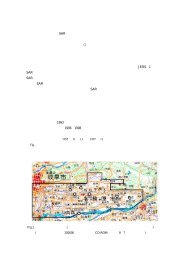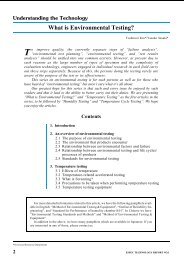Measuring conductivity of proton conductive membranes in the ...
Measuring conductivity of proton conductive membranes in the ...
Measuring conductivity of proton conductive membranes in the ...
You also want an ePaper? Increase the reach of your titles
YUMPU automatically turns print PDFs into web optimized ePapers that Google loves.
<strong>Measur<strong>in</strong>g</strong> <strong>conductivity</strong> <strong>of</strong> <strong>proton</strong> <strong>conductive</strong> <strong>membranes</strong> <strong>in</strong> <strong>the</strong> direction <strong>of</strong> thickness<br />
S<strong>in</strong>ce 4-probe measurements <strong>in</strong> <strong>the</strong> surface direction obta<strong>in</strong>ed results with better<br />
reproducibility, <strong>the</strong>se measurements were used as comparison reference aga<strong>in</strong>st <strong>the</strong><br />
measurements <strong>in</strong> <strong>the</strong> direction <strong>of</strong> thickness <strong>of</strong> <strong>the</strong> membrane. The specimens for 4-probe<br />
surface direction measurements were prepared by press-fitt<strong>in</strong>g metal sheets to both<br />
ends <strong>of</strong> <strong>the</strong> Nafion ® membrane and vertically pierc<strong>in</strong>g <strong>in</strong>to <strong>the</strong> membrane near <strong>the</strong> center<br />
with plat<strong>in</strong>um wires.<br />
Fig. 1 (a) and (b) respectively show schematics <strong>of</strong> <strong>the</strong> specimens for <strong>the</strong> 2-probe and<br />
4-probe measurements <strong>in</strong> <strong>the</strong> direction <strong>of</strong> thickness, while (c) shows <strong>the</strong> same for <strong>the</strong><br />
4-probe surface direction measurements.<br />
Fig.1 Sample arrangements for (a) <strong>the</strong> 2-probe method, (b) <strong>the</strong> 4-probe<br />
method <strong>in</strong> <strong>the</strong> direction <strong>of</strong> thickness, and (c) <strong>the</strong> 4-probe method <strong>in</strong><br />
<strong>the</strong> surface direction<br />
2-3 Conductivity Measurements<br />
A specimen fixed to a measur<strong>in</strong>g cell was placed <strong>in</strong>side a temperature and humidity<br />
chamber under constant temperature and humidity (80°C, 30 to 90% rh). AC impedance<br />
measurements were taken us<strong>in</strong>g a computer-controlled Solartron Instruments model<br />
1260 impedance ga<strong>in</strong>/phase analyzer and a computer-controlled 1287 electrochemical<br />
<strong>in</strong>terface, and Cole-Cole (Z’-Z’’) and Bode (log|Z|-log Frequency and <strong>the</strong>ta-log<br />
Frequency) plots were obta<strong>in</strong>ed. The frequency limits <strong>of</strong> <strong>the</strong> s<strong>in</strong>usoidal signals were<br />
typically set between 5 MHz and 0.01 Hz, with an oscillation <strong>of</strong> 10 mV. Assum<strong>in</strong>g a circuit<br />
equivalent to <strong>the</strong> one shown <strong>in</strong> Fig.3, a best-fitt<strong>in</strong>g curve was overlaid onto <strong>the</strong><br />
measurements taken by <strong>the</strong> 2-probe method. Conductivity was calculated from <strong>the</strong><br />
obta<strong>in</strong>ed membrane resistance, Rbulk, us<strong>in</strong>g <strong>the</strong> follow<strong>in</strong>g formula.<br />
…(1)<br />
Where σ is <strong>conductivity</strong> (Scm-1 ), L is membrane thickness (cm), A is electrode area<br />
(cm2 ), and R is resistance (Ω).<br />
- 15 -<br />
Espec Technology Report No20



